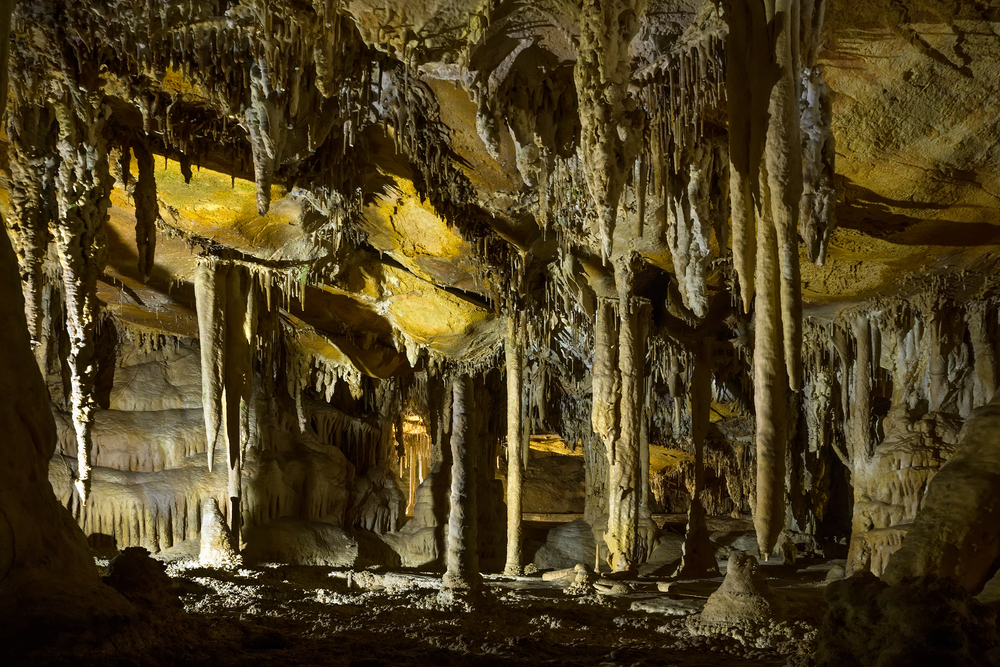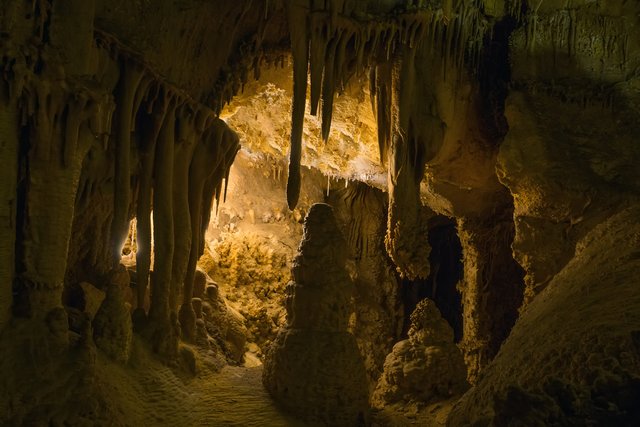
"There are two sorts of rocks in Lehman Caves," the recreation center officer told the gathering. "Headbangers and kneeknockers. Look for both when you're in there." Then she drove us through an overwhelming entryway and into a long solid passage. The patter of our strides hustled and crashed along the passage's length. The peaceful, 50-degree Fahrenheit (10-degrees Celsius) air chilled us as we went through the entryway that finished the sealed area, and we at long last entered the underground maze.
At the point when the sun is setting, Great Basin National Park in east-focal Nevada lies in the shadow of the Snake Range's Wheeler Peak, which, at 13,063 feet (3982 meters), is the most elevated point completely inside Nevada. A huge number of years prior, magma interrupted into the joint between the quartzite, constituting the greater part of the Snake Range, and the limestone along the range's eastern flank. The magma's warmth transformed a portion of the limestone into marble. That was the vital initial phase in the development of the caverns.
At one time, the atmosphere of eastern Nevada was more moist than it is today and, thusly, the water table was higher. Water, which assimilates carbon dioxide from the air to frame carbonic corrosive - the feeble corrosive of pop - doused into the ground and broke down the marble. As the atmosphere dried, the water table dropped, and the streaming water rose into vaulted rooms and ways. Losing its carbon dioxide, the fluid stored its weight of the mineral calcite (calcium carbonate) at the slower than snail's pace - an inch for every century - to frame pop straws, stalactite knifes, stalagmite stumps, strange shields, agile draperies and segments taking after the remnants of old Greece. To keep the distinction between give in highlights clear in your psyche recall that "stalactites" has the letter "c" and this component descends from the roof, and the word for the other surely understood element "stalagmites" has the letter "g" and comes up starting from the earliest stage. So it's "c" for roof (stalactite) and "g" for ground (stalagmite).
All things considered, stalactites end up being pop straws that ended up plainly stopped up. Pop straws have mineral-loaded dilute trickling through the inside and abandoning rings of minerals that can expand extraordinary separations if left undisturbed, up to 30 feet (9 meters). In the event that the end winds up noticeably stopped, be that as it may, dilute can begin dribbling the outside of the straw leaving minerals outwardly of the straw that keep on growing an outward way, in this manner getting to be stalactites, as the previous straw now begins to thicken.
Into the Gothic Palace
As the officer drove us past the give in's common passageway and into the Gothic Palace, she delayed to enlighten us concerning Absalom S. Lehman. The proprietor of a farm on the eastern slants of Wheeler Peak, Lehman found the collapse 1885. In that year, he guided 800 individuals through its rooms and paths; guests needed to move down steps into the vertical passageway, utilizing just light lamps for enlightenment, as indicated by the officer.
At the point when our gathering was somewhat more remote along the way, the officer killed the electric lights, leaving just a flame lamp as our light source. As she raised the light starting from the earliest stage, shadows moved over the by one means or another augmented chamber. "Would you be able to envision investigating the caverns along these lines?" she inquired. After the lights were exchanged back on, we proceeded with our six-tenths of a mile (1 km) travel through the white complex of thin, winding paths and voluminous chambers. A few hallways resembled workmanship exhibitions showing their models transparently. Different passageways clouded their fortunes in bewildering folds.
The Wedding Chapel and Beyond
After the Gothic Palace, with its angling roof and tall sections, we achieved the roomy Wedding Chapel, which was really utilized for five wedding services in the nineteenth century. In the nearby Music Room, early visit aides would create melodic notes by tapping on the stalactites with hammers. In any case, this training was ceased after a portion of the stalactites were discovered disintegrating.
Up past wooden stairs, our gathering happened upon the Tom-Tom Room, which has the most acclaimed topographical element of Lehman Caves - saucer-molded plates called shields or beds, calculated out from the dividers. Nobody knows precisely how shields create. They may frame when water, under weight, rises through breaks in the dividers to store thin movies of calcite, making various sets of confronting plates that appear to resist gravity. Bit by bit, water manufactures segments underneath huge numbers of these shields. They just happen in one percent of all known limestone holes; so Lehman Caves would be exceptional if just for its wealth of shields.
Going past the Dragon's Den and the Queen's Chamber, the officer achieved the Lodge Room at the intersection of the trail framework in the holes. She portrayed how Clarence T. Rhodes, the main caretaker of the surrender after it had turned out to be open property, had encouraged individuals from the Knights of Pythias and the Boy Scouts from adjacent Ely, Nevada, to hold their gatherings here. Since the legislature didn't have any cash in the state spending plan to pay him. Mr. Rhodes was qualified for any expenses he may charge for affirmation and, along these lines, had a personal stake in advancing the hollows. Tragically for the Lodge Room, those guests thumped down a portion of the roof developments to give headroom, and the residue from their flames is as yet obvious along the dividers.
On through a passage, the officer drove us to the Inscription Room. A look at the dingy letters and numbers on the roof and dividers quickly disclosed to us the explanation behind the name. In the wake of pointing them out, the officer sparkled her electric lamp alongside the passage we had come through to demonstrate to us a low slither space. "This is the old approach to get into this room," she clarified. With just a 18-inch (45 cm) leeway, the entry earned the name of Fat Man's Misery for those early guests who endured. To praise their mission, they denoted the stay with their initials or the date, the most punctual of which is from the 1890's.
The plunking of water welcomed us in the Cypress Swamp. Smaller than usual divine forces of Mt. Olympus may have abounded in the fragile, rimstone-diked pools alongside a couple of inquisitive, calcite animals. The biggest pool was named Lake Como, by Mrs. Rhodes after the well known lake in the Italian Alps.

The Nature Trail
Outside the leave burrow, a nature trail starts. By tailing it, you can take in more about the historical backdrop of the recreation center at the old lodge where Clarence Rhodes once lived, and get to know the trees and bushes of the recreation center. As a matter of fact, the Snake Range gives you the chance to investigate five diverse plant groups, speaking to the adjustments in vegetation from Mexico to Alaska. The principal group, the upper Sonoran, named after Sonora, Mexico, encompasses Lehman Caves with piñons and junipers and reaches out down toward the Snake Valley.
By driving 12 miles (23 km) around the Wheeler Peak Campground, you can see whatever is left of the life zones. The progress zone of ponderosa pines, white fir and mountain mahogany starts around the Lehman Creek Campground, which has the biggest mountain mahogany (Cercocarpus ledifolius) on the planet. Trembling aspens are here and on up the mountainside.
Higher up the lofty, bending street, close to the Peak ignore, the Canadian life zone starts, with Douglas fir and Englemann spruce prevailing. From the disregard, rocky Mount Jefferson Davis is to one side and Wheeler Peak is to one side.
One might say, you're nearing the Hudson Bay when you influence it to the Wheeler To crest Campground at around 10,000 feet (3048 meters). Agile pine, Engelmann spruce, and aspens shade the campgrounds. A trail framework drives you to timberline, the most astounding edge of the Hudsonian zone, where an interpretive trail demonstrates to you the most seasoned living things on the planet - bristlecone pines (Pinus longaeva). The most established bristlecone, at right around 5,000 years, developed on the inclines of Wheeler Peak before being chopped down in 1964.
It was named Prometheus by local people, who gave singular trees names including Buddha and Socrates. The story has it that a geographer contemplating Ice Age highlights attempted to take a center example of Prometheus keeping in mind the end goal to discover its age. At the point when the center specimen exhausting device broke, he depended on chopping it down, with the Forest Service's authorization. It was just a while later when he checked the rings that he understood he had chopped down the most established known tree on Earth. It was later resolved to be 4862 years of age. More seasoned bristlecone pines have been measured throughout the years since, however for a period, Prometheus held the record.
Ultimately, the Arctic-Alpine zone stretches out up to the summit of Wheeler Peak, achievable by climbing 2,600 feet up a strenuous four-mile (6.5 km) trail. Little develops in this zone, with the exception of lichens, greeneries, some tough wildflowers and grasses in secured places.
The best shake craftsmanship in eastern Nevada, however, is simply the figures that Nature made in Lehman Caves.
Assets
To get to Great Basin National Park, drive around 68 miles (110 km) east from Ely, Nevada, along joined U.S. Highways 6 and 50 to their intersection with State Route 487, at that point south to Baker and, at long last, west along Route 488. Give in visits, which most recent a hour for the Lodge Room visit to 90 minutes for the Grand Palace visit, cost $8 and $10, individually for grown-ups, or $4 and $5 separately for kids 5 - 15 years of age and seniors, yet are free for youngsters under 5 for the Lodge Room visit. Kids under 5 are not permitted on the Grand Palace visit. Today, a cleared way and passages make spelunking aptitudes pointless yet regardless it has some level of wellness for these visits.
Image Source: shutterstock



Very nice post! Upvoted. Thanks for be a part of the steemit.vote community!
Downvoting a post can decrease pending rewards and make it less visible. Common reasons:
Submit
Nic Post and Every time i see your post, i always feel happy and happy. and I Follow u and U Follow Me and Upvote...!!
Downvoting a post can decrease pending rewards and make it less visible. Common reasons:
Submit
Nice post @funaddaa about Lehman cave and its rock formation. Both the photographs are taken beautifully a 3D effect can be seen in these photographs.
Downvoting a post can decrease pending rewards and make it less visible. Common reasons:
Submit
nice post friend
Downvoting a post can decrease pending rewards and make it less visible. Common reasons:
Submit